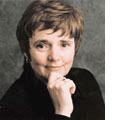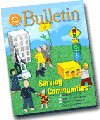
Community and shalomBy President Shirley H. ShowalterBenedict, like many Christian thinkers before and after, discovered how hard it is to live in community. He knew that the freedom to be inclusive in love was a precious gift and not an automatic one. To help retain his own learning and to help novices, he wrote a “little rule for beginners” that is today called The Rule of Saint Benedict. Among the many wise exhortations and admonitions in The Rule is this one intended for abbots: “arrange everything so that the strong have something to yearn for and weak nothing to run from.” As I envision the future of Goshen College, I see a place which continues to arrange a liberal arts education so as to connect community and peace. We equate the Hebrew word shalom with peace, a deep kind of peace beyond the absence of conflict. Shalom is God’s original design for the world, which so often lies in ruins. The Bible contains vivid images of shalom. In Psalms 85:10, mercy and truth are joined, and justice and peace kiss each other. In Isaiah the righteous will “beat their swords into plowshares” and the “lion will lie down with the lamb.” In Revelation, the righteous from “every tribe and nation” will stream to the throne and be united with the lamb. These biblical visions are not intended only for a millennial future or for heaven. They are intended to guide our actions now. To rephrase Benedict, we need to yearn for peace and justice – and we need to go from yearning to action. That action must focus on the safety from fear we want everyone to experience. Our students develop a thirst for peace out of their experience of living in community and learning about it in classes. They expect us to walk our talk. I am writing these words somewhere over the Rocky Mountains – flying from Seattle to Chicago. A team of five has spent more than two days thinking hard about diversity and community. The dream we share is of a community that serves its students and its church best by serving the world. The dream of shalom created the theological base for many of our strongest and most distinctive programs – most notably the Study-Service Term. The same dream gave birth to our three newest majors – peace, justice and conflict studies, environmental science, and American Sign Language Interpretation. I find a connection between the current conference and the ancient admonition to abbots in St. Benedict’s Rule. The abbot’s task in the monastery was to arrange everything for the benefit of the whole. Everyone needs to feel safe before they can yearn for a vision as large as shalom. Only when our community is as diverse inside as the world around us can all our members feel safe. It is tempting to mythologize community. Many of my generation of faculty have heard stories, for example, about the good old days of community when all of the faculty and their families looked forward to annual retreats at Little Eden in Michigan. The conditions were rugged, but, at least in the legends, the flies in the kitchen only made the job of washing dishes more fun. Such community is a wonderful legacy to honor and to learn from –- even we who were not there treasure it. The Little Eden experiences of the past cannot be repeated, but instead of focusing on what is lost from the 1950s and ’60s versions of community, we must look at what can be. The team we sent to Seattle was composed of two white women, two African-American men and one Hispanic man. Four were from Goshen College, and one was a retired executive from Elkhart. The conference as a whole consisted of 60 percent whites and 40 percent people of color. We ate, worked and worshipped together. We caught a glimpse of what inclusive community will be like as we continue on the journey toward shalom. The vision is glorious. The work is now. |
| Top of page |


